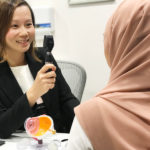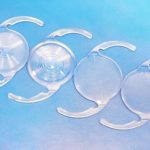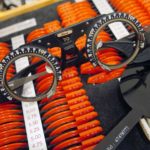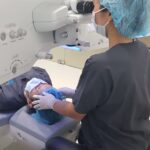Age-Related Macular Degeneration
What is Age-Related Macular Degeneration?
Age-Related Macular Degeneration, often abbreviated as ‘AMD’, is a chronic, irreversible eye condition. AMD damages the retina, resulting in loss of vision in the centre of the visual field. AMD is one of the leading causes of blindness in people 50 years and older.
There are two types of AMD – dry AMD and wet AMD.
Dry AMD: the more common form of AMD. It occurs when light-sensitive cells in the macula (the central area of the retina) gradually break down with age, slowly causing loss of vision.
Wet AMD: is less common than dry AMD – it is estimated that only around 1 out of 5 people with AMD have wet AMD. Furthermore, it usually develops in people who already have dry AMD. Studies have shown that people who smoke are 4 times more likely to develop wet AMD [1].
Wet AMD is caused by growth of blood vessels under the retina in the macula. Because they leak substances such as blood, fluids, lipids and proteins, these small abnormal blood vessels disrupt the normal structure of the retina, form scar tissue, and cause loss of central vision. In the absence of prompt treatment, wet AMD can cause significant vision loss within a short period of time.
What Causes Age-Related Macular Degeration?
Known risk factors of AMD include:
- Age: a study found that 1 in 4 Singaporeans aged 60 and above suffer from AMD [2]
- Cardiovascular diseases, high blood pressure, high cholesterol levels, and obesity
- Having a family history of AMD
- Smoking
What Are The Symptoms of AMD?
Oftentimes, early stages of AMD do not present symptoms. However, as AMD progresses, known symptoms include:
- Loss of contrast sensitivity in vision
- Problems differentiating colours
- Gradual or rapid blurring of central vision
- Missing or blank spots in vision
- Following exposure to bright light, slow recovery of vision
- Distortion of vision (see Amsler Grid below)
Amsler Grid

With normal vision, the grid appears uniform, without gaps or distortion, with the lines being entirely straight (left). In contrast, an eye with AMD will view it as shown on the right.
Age-Related Macular Degeneration Treatment
Due to the severe and irreversible impacts of AMD, it is necessary to seek immediate treatment.
For wet AMD, your doctor may prescribe supplements to slow down progression of the disease in the eye.
Treatment options for dry AMD include:
- Intravitreal injections: medications are injected into the eye to block the growth of abnormal block vessels (Eyelea, Lucentis)
- Photodynamic lasers and laser photocoagulation (Pan-Retinal Photocoagulation)
Is There Any Way To Prevent Age-Related Macular Degeneration?






Technology
ISEC believes in continuous innovation, we regularly update our medical technology according to the latest industry developments.
Touch
Rest assured in the hands of experienced doctors with many years of surgical experience, as well as seasoned nurses and optometrists.
Trust
ISEC’s reputation is one that has been built around experience and trust, as evidenced by our large pool of referral patients.
